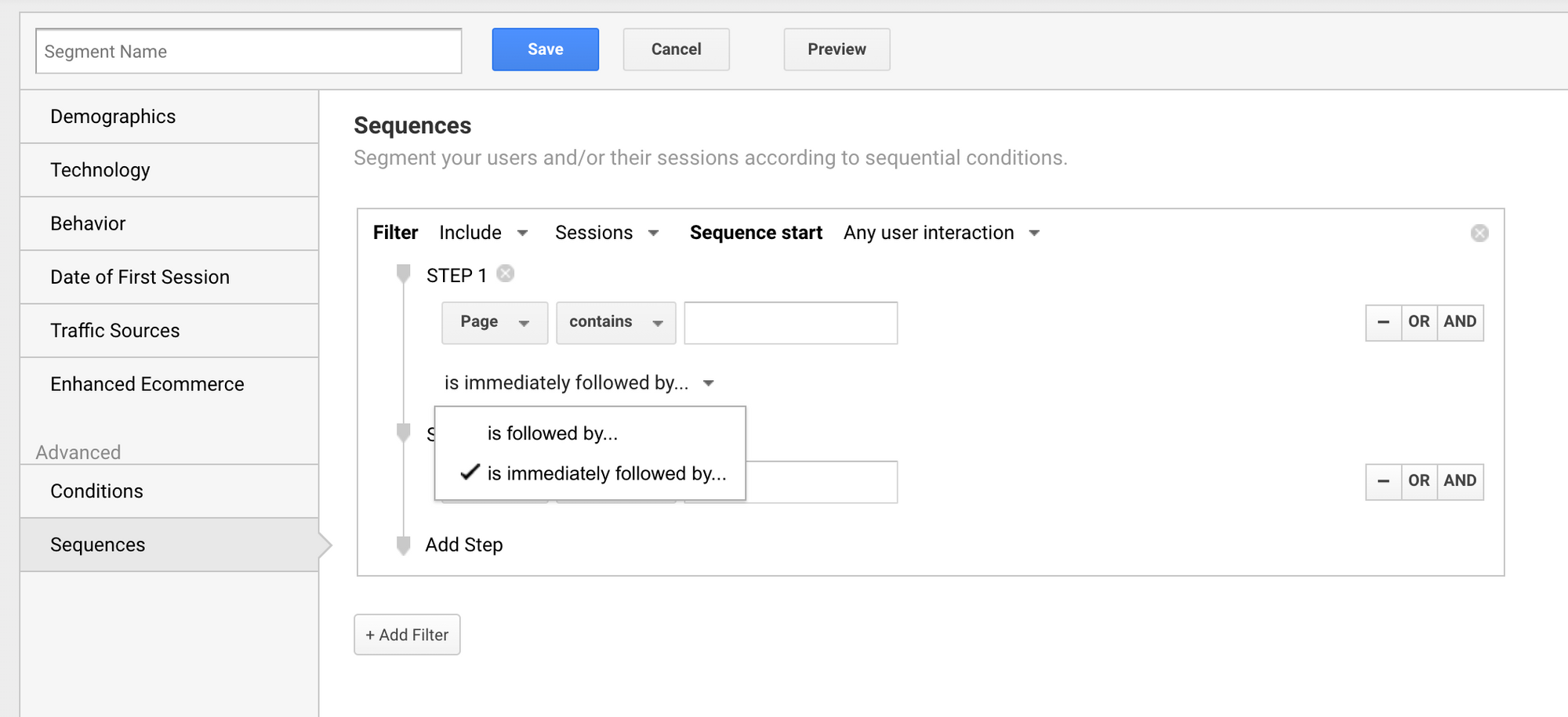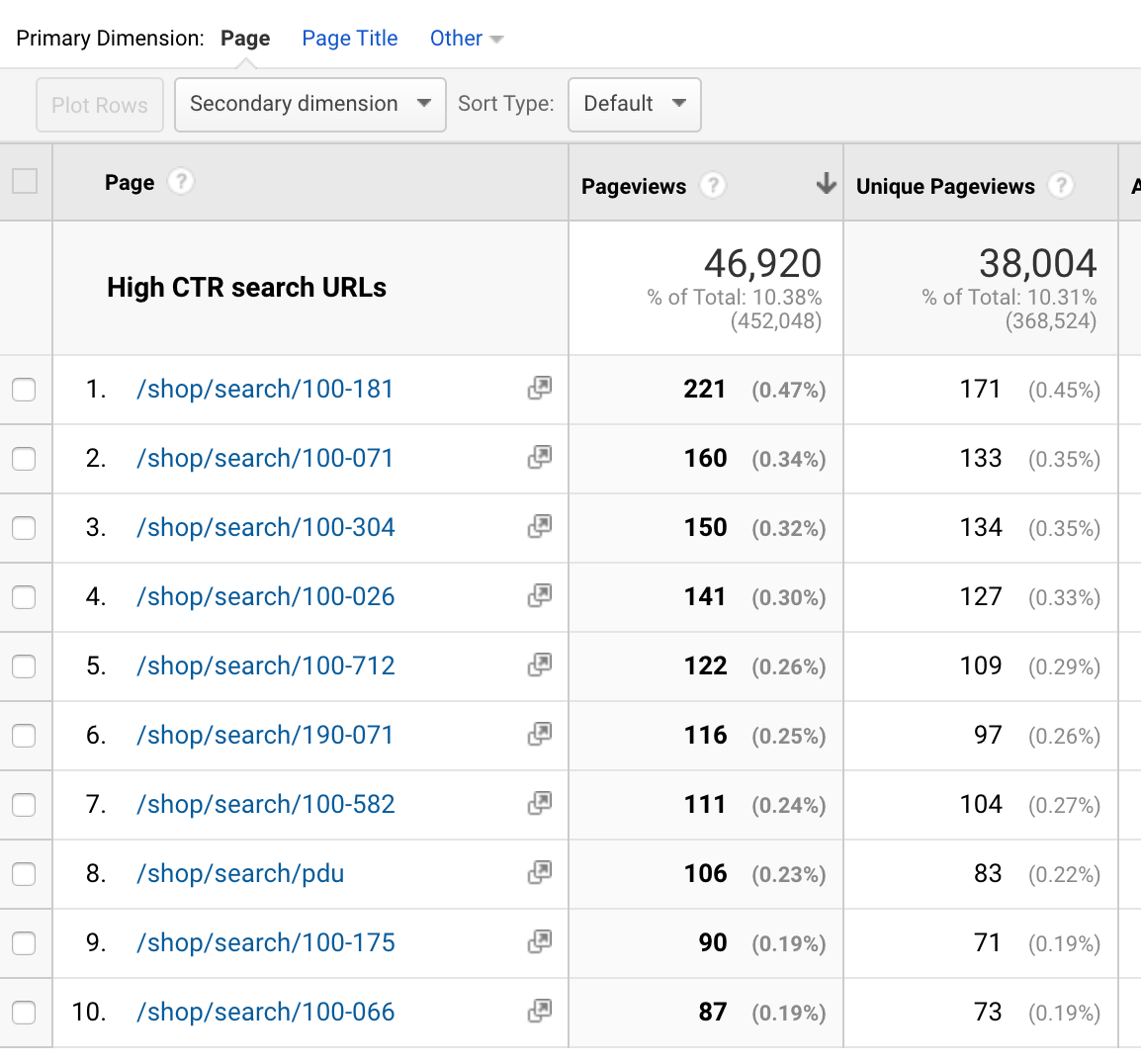In a perfect world, internal search URLs would never be used by the merchandising or marketing teams to link to products or categories internally. Those that link to our eCommerce sites would take the time to find the proper category, brand or product URLs instead of yup, you guessed it – search URLs.
In a workplace where everyone plays by the rules meticulously, internal search URLs would be reserved for precisely what they were intended for. Yup searching for stuff – internally!
But hey, it’s not a perfect world, which is precisely why considering your internal site search URLs when you’re migrating is not a ‘nice to have’, it’s a ‘must have’ to ensure your migration isn’t left with gaping holes post-transition.
SIte search or internal search URLs are often one of the most neglected subsets of URLs when it comes to upping sticks and moving to a new website.
To make matters worse, it’s often the most difficult to determine just how much damage it has caused once a migration has been completed and search URLs weren’t addressed. With such a huge pool of URLs (often in to the millions) identifying impact after a website transition is a real challenge.
Site search migration is essential to ensuring your migration is not just a SEO success but a commercial success too. Whether you’re migrating to an all new URL structure or just a new domain name, it’s time to stop forgetting about those often missed but cash-rich search URLs and get ’em migrated properly!
So, why the hell should I care about migrating site search URLs?
Customers that use your website’s internal site search are 50% more likely to convert compared to those that do not.
Customers and shoppers that use site search are 50% more likely to convert compared to those that do not
The last thing you want is to disregard the migration of URLs that are conversion-rich, and are collectively responsible for delivering buckets of cash and sales for your website by proactively making it easier for your customers to buy what they’re looking for.
Secondly, up to 30% of your visitors will use site search at least once during their visit – far from negligible.
Ok, so why are search URLs so often ignored when migrating?
The main reason? Internal search URLs often aren’t hard-hitting from an SEO authority perspective and when a website is migrated without considering SEO at all (yes, this still happens in 2020) even basic URL mapping is unlikely to even be glanced at.
This ultimately means internal search URLs are left in the cold. Not migrating such key URLs is only likely going to hit your eCommerce website where it hurts; costing you both customers and sales.
When it comes to a site’s migration, typically SEO retention is the core objective.
I’m not here to throw down any controversy, SEO absolutely should be a core objective. But a migration is also deeper and wider than just SEO alone.
A migration also has to consider and focus on CRO and UX too, especially in the world of ecommerce. For example, you can have a solid tech SEO migration with all equity preserved and carried across etc, but if it’s a PITA to use, or critical URLs are mis-redirected, you’re going to lose customers and sales.
When you look at a site’s internal search URLs, depending on how it’s been structured, there are often millions of internal search URLs to consider; once you’ve considered all the different search terms and their respective filters and refinement parameters.
Often these plethora of internal search URLs pose little threat to SEO authority, which is why they’re so often neglected when it comes to a site’s migration.
Yes, individual site search URLs might pose little threat to SEO, but as a collective, they could make up a pretty sizeable chunk of an eCommerce website’s authority, commercial potency and structure. Here lies the problem.
But let’s consider the bigger picture (and the real world) here..
Search URLs often power internal links
It’s no secret that promotional banners, categories or featured items on an eCommerce website can be linked to using internal search URLs. Especially during a sale period. Not only that, they’re often linked to on the home page too, arguably the most powerful page when it comes to SEO.
In essence, these search URLs need to be identified and migrated too.
Search URLs can also collect authority via backlinks
Although there may not be many of them to contend with, equity can be passed via backlinks using search URLs too. Especially if you’re eCommerce website resells products from other brands.
Backlinks from official brand websites can deliver powerful keyword opportunities, it’s important these backlinks to search urls from brand websites are preserved to best ensure keywords and respective rankings are preserved.
Many major and noteworthy brands often have ‘stockists’ pages with a list of featured retailers on their websites. These retailers can often be linked to using internal search URLs

Site search URLs can feature heavily in emails
Often the team and person(s) responsible for email marketing are rarely affiliated with SEO or website URLs disciplines when defining which links to use for email.
Providing the destination is correct, that’s usually what’s important. This often means that the chosen hyperlinks are search URLs.
Although the URLs used in emails have very little to do with SEO, ensuring links in emails continue to work post-migration prevents customer frustration and purchase abandonment.
Internal search URLs often have less to do with SEO and much more to do with UX & CRO
The point I’m trying to make here is that although search URLs may not be high on an SEOs agenda, they’re no less powerful or important from a commercial perspective.
Maintaining and redirecting internal search URLs has less to do with SEO and a lot more to do with maintaining conversion performance and user experience
Ok, got it – so how do I properly migrate search URLs?
Firstly, you need to identify the search URLs that need to be prioritised and reviewed / considered in greater detail. To identify which URLs are key, here’s the prerequisites I review.
First, identify search URLs that have noteworthy backlinks
Doing so will help you identify the search URLs that have the most SEO potential.
In some cases these high authority search URLs can be migrated to a destination that can better take advantage of the acquired equity.
For example, let’s say you’ve a eCommerce website selling suits and you’ve the search URL ‘men’s slim fit suits’ that’s attracted a number of impressive backlinks.
Instead of simply redirecting to the same search URL on the new website (/search/mens+slim+fit+suits/), the website would likely rank better if it was redirected to the equivalent category URL instead (/suits/mens/slim-fit).
Doing so comes with a number of benefits. By migrating to a more suitable URL, you’re enforcing a better IA, better recycling acquired equity. Not only this, but category URLs as landing pages also typically convert better than their equivalent search URLs too.
Secondly, identify search URLs that consistently generate high volumes of traffic
Identifying these URLs and search terms allows you to find and isolate the search URLs that are essential for your audience and therefore should take precedence when creating redirects and testing them.
It’s essential to ensure these URLs are redirected as expected. Your visitors search for these terms in consistently high numbers each month. To avoid eroding sales and conversion performance, these URLs need to be a priority addressed early on.
As these URLs are key, more time can be spent on them to decide and define the best possible destination that they should be redirected to. Some questions to consider could be:
- Should they simply be redirected to the same search result on the new website?
- Is there a better serving URL that a high traffic search term should be redirected to?
- Are you still selling the products that large quantities of visitors are searching for?
How you handle each of these collective URLs will determine their respective destinations.
Next, identify search URLs that consistently convert well
So you’ve now identified the search URLs that are authoritative and are accessed widely by your customers and visitors. Now it’s time to identify the internal search URLs that convert well.
Determining these URLs allows you to clearly understand which search URLs are responsible for delivering significant conversion performance. You can then focus on ensuring the behaviour and customer experience is mirrored or correctly catered for when migrating them.
Using Google Analytics, you can identify these high converting search URLs by firing up the landing page report, sort by Ecommerce Conversion Rate and refine by your internal search URLs.
Identify search URLs that generate high CTR
Although search URLs with a high clickthrough rate may not directly impact conversion, a high CTR demonstrates that these search URLs are helping customers and visitors find what they’re looking for, making it easier to buy. It’s important to ensure this level of ‘findability’ remains intact post migration too.
You can get an idea of CTR using Google Analytics and although the data is not entirely conclusive, it is indicative and helps you to identify URLs with the strongest CTRs nonetheless.
To get your hands on the dataset in GA, first you’ll need to build a new custom segment. In the advanced section, you’ll want to click on ‘sequences’
You’ll then need to configure two steps. It’s also important that you select ‘is immediately followed by’ as demonstrated below:

[Case Study] Managing Google’s bot crawling
For the first step, you’ll need to set the match type to ‘contains’ and in the field, enter the URL pattern that denotes a internal search URL (for example, /search/)
For the second step, again you’ll need the ‘contains’ match type and you’ll also need to enter the URL pattern that defines the URL is a product (for example /product/)
Name and save the segment and head over to the ‘All pages’ report filtering the results to solely search URLs. You’ll then have a rough list showing all search URLs that have a high CTR as shown in the example below:

This list of URLs can then be used to ensure that search results and customer experience is consistent post-migration and that customers are able to find the products they’re looking for just as easy as they did prior.
Ok, so now i’ve my shortlisted search URLs, what do I do with all the others?
Depending on the size of your website and how embedded search URLs are in your site’s landscape, you could have a shortlist of tens or thousands of shortlisted search URLs – however, this is only a small part of the overall search migration picture.
If your internal search URL structure uses parameters, you’ve possibly millions of additional URL combinations to consider alongside your shortlisted search URLs.
The good news is, a solid rule and logic setup will take care of these without impacting UX, customer experience and conversion.
Define your rules to bulk redirect the remainder of internal search URLs
The remainder of search URLs to migrated can be passed through a 3-step logic to ensure your search URLs are migrated effectively.
Preserve the search query
This might be obvious, but it can’t be overstated. It’s essential that the search query in the original URL is mirrored exactly in the destination / migrated version of the URL. Whether the search term is passed to the YRL as a parameter, subfolder or other.
Failing to preserve the search query exactly will dramatically compromise the migration of search URLs and their relative performance. Pay particular attention to spaces, special characters and accents (if applicable).
Strip all but the first parameters (not including the search term)
This might sound dramatic, but hear me out. Parameters layered on to search URLs complicates the original query and dramatically increases the chances of the search URL returning zero results or ‘no items found’.
Not only this, but each additional parameter added to the URL increases the page load time and demand on resources.
There are also parameters that add little to no value to the original search query such as pagination, sort order and view (grid vs row layout for example)
Preserving the first parameter in the URL is often enough to keep the results relevant enough without slowing the page load, and increasing the risk of ‘no results found’
Explicit shortlisted redirects must always override automated rules
Shortlisted URLs are often managed and handled differently to the global ruleset that you’ll define. It’s therefore essential that any manually curated redirects are respective and override any global rules.
This ensures that your key and powerful priority search URLs are redirected as intended.
I’m all set! Is there anything I can do to keep tabs on performance?
Absolutely! Here’s the second major benefit of having a definitive shortlist of priority internal search URLs to migrate. You can use the KPIs of these pre-migration URLs to benchmark against their new equivalents again using Google Analytics.
- How well did the old URL convert as a landing page?
- How many organic visits did the old equivalent URL receive each month and how is it shaping up vs the new?
Keep tabs on the number of redirected URLs returning ‘no results found’
This is a great way to keep a bird’s eye view on UX and conversion performance post migration.
With a small amount of input from web dev, you can pass an event to Google Analytics using dataLayer that fires whenever a requested search URL contains zero results.
dataLayer.push({‘event’:’GAE’,
‘GAE’:{
‘category’:’site search’,
‘action’:’no results found’,
‘label’:’search term’}
});
Firing this dataLayer.push event would store all the search queries and specific search URLs that fired zero results along with their frequency.
This data can then be used to rectify the search results so that relevant products are returned or amend the search URL redirect so that it provides a better UX for your visitors.
Want to learn more about dataLayer? This post by Simo Ahava’s is a great place to start!
In summary
Don’t ignore your search URLs, they’re a cornerstone of sales and conversion
As explained and detailed above, ignore your search URLs at your peril! Search URLs are often some of the most powerful when it comes to what really matters for eCommerce; delivering a solid UX, strong conversion and capturing sales.
Define a solid redirect rule set with your webdev team to ensure a best matched destination is defined at scale
Defining manual 1:1 redirects for every search URL on your site is likely to be outrageously time intensive requiring 100s of hours to complete. Absolutely not possible for many and extremely inefficient.
By focussing time and effort on your essential and shortlisted search URLs, the remaining vast majority of them can then be managed using a predefined set of rules; balancing both efficiency and impact
Test by crawling your shortlisted search URLs as a bare minimum
Your shortlisted URLs are the handpicked URLs that your website can’t afford to get wrong. Using list mode in your chosen crawler to firstly check that the URLs infact redirect via a 301 and secondly that the destination is correct.
This is the absolute minimum that should be checked and crawled. Ideally you want to crawl all (if that’s not possible a significant sample) of your pre-migration search URLs.
For additional data to test against, export the maximum number of pre-migration search URLs from your google analytics account. You can use list mode to crawl these too and ensure redirect logic is firing as required.
This way, you can be sure that your redirect rules are robust, or if they aren’t quite right, what specifically is causing the logic to fail.
Finally when testing, take the opportunity to test some of the more unusual and edge case queries and parameters. You’ll be amazed just how quickly redirects can fail when presented with abnormal queries or parameters
Identifying your key URLs and ensuring the redirect rules and logic is watertight is essential for a successful migration. Get it right, and your migration will be both technically sound and customer-centric too.
Good luck!

